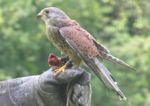Avian Oral Cavity - Anatomy & Physiology
Introduction
In avian species, the lips and cheeks are replaced by the beak.
The beak is an area of dense, horny skin overlying the incisive bones of the mandible.
No modern birds possess teeth, however rudimentary enamel organs have been discovered in the embryos of some birds.
The size and structure of the avian tongue varies between species; it is related to the functional requirements of each species.
The avian hard palate contains a slit-like opening called the choanal opening which communicates with the nasal pharynx.
| Avian Oral Cavity - Anatomy & Physiology Learning Resources | |
|---|---|
 Test your knowledge using flashcard type questions |
Avian Alimentary Tract |
Anatomy Museum Resources |
Avian Interactive Anatomy - Bucopharyngeal Cavity 1 Avian Interactive Anatomy - Bucopharyngeal Cavity 2 Avian Interactive Anatomy - Bucopharyngeal Cavity 3 Avian Interactive Anatomy - Bucopharyngeal Cavity 4 Avian Interactive Anatomy - Bucopharyngeal Cavity 5 Avian Interactive Anatomy - Bucopharyngeal Cavity 6 |
Error in widget FBRecommend: unable to write file /var/www/wikivet.net/extensions/Widgets/compiled_templates/wrt662324b30def97_73062020 Error in widget google+: unable to write file /var/www/wikivet.net/extensions/Widgets/compiled_templates/wrt662324b312b290_67060755 Error in widget TwitterTweet: unable to write file /var/www/wikivet.net/extensions/Widgets/compiled_templates/wrt662324b31b0429_93023199
|
| WikiVet® Introduction - Help WikiVet - Report a Problem |

